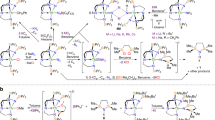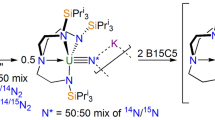Abstract
Understanding the bonding, reactivity and electronic structure of actinides is lagging behind that of the rest of the periodic table. This can be partly explained by the challenges that one faces in experimental studies of such radioactive compounds and also by the need to properly account for relativistic effects in theoretical studies. A further challenge is the very complicated electronic structures encountered in actinide chemistry, as vividly illustrated by the naked diuranium molecule U2. Here we report a computational study of this emblematic molecule using state-of-the-art relativistic quantum chemical methods. Notably, the variational inclusion of spin–orbit interactions leads not only to a different electronic ground state, but also to a lower bond multiplicity compared with those in previous studies.
This is a preview of subscription content, access via your institution
Access options
Access Nature and 54 other Nature Portfolio journals
Get Nature+, our best-value online-access subscription
$29.99 / 30 days
cancel any time
Subscribe to this journal
Receive 12 print issues and online access
$259.00 per year
only $21.58 per issue
Buy this article
- Purchase on Springer Link
- Instant access to full article PDF
Prices may be subject to local taxes which are calculated during checkout


Similar content being viewed by others
Data availability
All relevant data that are not included in this article and its Supplementary Information are available from the corresponding author upon reasonable request.
References
Lewis, G. N. The atom and the molecule. J. Am. Chem. Soc. 38, 762–785 (1916).
Neidig, M. L., Clark, D. L. & Martin, R. L. Covalency in f-element complexes. Coord. Chem. Rev. 257, 394–406 (2013).
Kaltsoyannis, N. & Kerridge, A. in The Chemical Bond: Chemical Bonding across the Periodic Table (eds Frenking, G. & Shaik, S.) 337–355 (Wiley, Weinheim, 2014).
Cary, S. K. et al. Emergence of californium as the second transitional element in the actinide series. Nat. Commun. 6, 6827 (2015).
Ferrier, M. G. et al. Spectroscopic and computational investigation of actinium coordination chemistry. Nat. Commun. 7, 12312 (2016).
Dutkiewicz, M. S., Apostolidis, C., Walter, O. & Arnold, P. L. Reduction chemistry of neptunium cyclopentadienide complexes: from structure to understanding. Chem. Sci. 8, 2553–2561 (2017).
Windorff, C. J. et al. Identification of the formal +2 oxidation state of plutonium: synthesis and characterization of {Puii[C5H3(SiMe3)2]3}−. J. Am. Chem. Soc. 139, 3970–3973 (2017).
Jung, J., Atanasov, M. & Neese, F. Ab initio ligand-field theory analysis and covalency trends in actinide and lanthanide free ions and octahedral complexes. Inorg. Chem. 56, 8802–8816 (2017).
Cross, J. N. et al. Covalency in americium(iii) hexachloride. J. Am. Chem. Soc. 139, 8667–8677 (2017).
Formanuik, A. et al. Actinide covalency measured by pulsed electron paramagnetic resonance spectroscopy. Nat. Chem. 9, 578–583 (2017).
Vitova, T. et al. The role of the 5f valence orbitals of early actinides in chemical bonding. Nat. Commun. 8, 16053 (2017).
Wilson, R. E., De Sio, S. & Vallet, V. Protactinium and the intersection of actinide and transition metal chemistry. Nat. Commun. 9, 622 (2018).
The bottom line. Nat. Chem. 9, 831 (2017).
Monreal, M. J. & Diaconescu, P. L. The riches of uranium. Nat. Chem. 2, 424 (2010).
Li Manni, G. et al. Assessing metal–metal multiple bonds in Cr–Cr, Mo–Mo, and W–W compounds and a hypothetical U–U compound: a quantum chemical study comparing DFT and multireference methods. Chem. Eur. J. 18, 1737–1749 (2012).
Penchoff, D. A. & Bursten, B. E. Metal–metal bonding in the actinide elements: conceptual synthesis of a pure two-electron U–U f δ single bond in a constrained geometry of U2(OH)10. Inorg. Chim. Acta 424, 267–273 (2015).
Foroutan-Nejad, C., Vicha, J., Marek, R., Patzschke, M. & Straka, M. Unwilling U–U bonding in U2@C80: cage-driven metal–metal bonds in di-uranium fullerenes. Phys. Chem. Chem. Phys. 17, 24182–24192 (2015).
Qu, N., Su, D.-M., Wu, Q.-Y., Shi, W.-Q. & Pan, Q.-J. Metal–metal multiple bond in low-valent diuranium porphyrazines and its correlation with metal oxidation state: a relativistic DFT study. Comput. Theor. Chem. 1108, 29–39 (2017).
Zhang, X. et al. U2@Ih(7)-C80: crystallographic characterization of a long-sought dimetallic actinide endohedral fullerene. J. Am. Chem. Soc. 140, 3907–3915 (2018).
Scheibe, B. et al. The [U2F12]2− anion of Sr[U2F12]. Angew. Chem. Int. Ed. 57, 2914–2918 (2018).
Lyon, J. T., Hu, H.-S., Andrews, L. & Li, J. Formation of unprecedented actinide≡carbon triple bonds in uranium methylidyne molecules. Proc. Natl Acad. Sci. USA 104, 18919–18924 (2007).
Hu, H.-S., Qiu, Y.-H., Xiong, X.-G., Schwarz, W. H. E. & Li, J. On the maximum bond multiplicity of carbon: unusual C–U quadruple bonding in molecular CuO. Chem. Sci. 3, 2786–2796 (2012).
Hayton, T. W. Recent developments in actinide-ligand multiple bonding. Chem. Commun. 49, 2956–2973 (2013).
Hlina, J. A., Pankhurst, J. R., Kaltsoyannis, N. & Arnold, P. L. Metal–metal bonding in uranium-group 10 complexes. J. Am. Chem. Soc. 138, 3333–3345 (2016).
Ephritikhine, M. Molecular actinide compounds with soft chalcogen ligands. Coord. Chem. Rev. 319, 35–62 (2016).
Fox, A. R., Bart, S. C., Meyer, K. & Cummins, C. C. Towards uranium catalysts. Nature 455, 341–349 (2008).
Liddle, S. T. The renaissance of non-aqueous uranium chemistry. Angew. Chem. Int. Ed. 54, 8604–8641 (2015).
Halter, D. P., Heinemann, F. W., Bachmann, J. & Meyer, K. Uranium-mediated electrocatalytic dihydrogen production from water. Nature 530, 317–321 (2016).
Arnold, P. L. & Turner, Z. R. Carbon oxygenate transformations by actinide compounds and catalysts. Nat. Rev. Chem. 1, 0002 (2017).
Bursten, B. E. & Ozid, G. A. Xα-SW calculations for naked actinide dimers: on the existence of ϕ bonds between metal atoms. Inorg. Chem. 23, 2910–2911 (1984).
Pepper, M. & Bursten, B. E. Ab initio studies of the electronic structure of the diuranium molecule. J. Am. Chem. Soc. 112, 7803–7804 (1990).
Gagliardi, L. & Roos, B. Quantum chemical calculations show that the uranium molecule U2 has a quintuple bond. Nature 433, 848–851 (2005).
Roos, B. O., Malmqvist, P.-Å. & Gagliardi, L. Exploring the actinide–actinide bond: theoretical studies of the chemical bond in Ac2, Th2, Pa2, and U2. J. Am. Chem. Soc. 128, 17000–17006 (2006).
Gorokhov, L. N., Emelyanov, A. M. & Khodeev, Y. S. Mass-spectroscopic investigation of stability of gaseous U2O2 and U2. High Temp. 12, 1307–1309 (1974).
Pyykkö, P. & Desclaux, J.-P. Relativity and the periodic system of elements. Acc. Chem. Res. 12, 276–281 (1979).
Reiher, M. & Wolf, A. Relativistic Quantum Chemistry: The Fundamental Theory of Molecular Science (Wiley, Weinheim, 2009).
Dyall, K. G. & Fægri, K. Introduction to Relativistic Quantum Chemistry (Oxford Univ. Press, Oxford, 2007).
Saue, T. Relativistic Hamiltonians for chemistry: a primer. Chem Phys Chem 12, 3077–3094 (2011).
Christiansen, P. A. & Pitzer, K. S. Electronic structure and dissociation curves for the ground states of Tl2 and T12 + from relativistic effective potential calculations. J. Chem. Phys. 74, 1162–1165 (1981).
Saue, T., Fægri, K. & Gropen, O. Relativistic effects on the bonding of heavy and superheavy hydrogen halides. Chem. Phys. Lett. 263, 360–366 (1996).
Blaise, J. & Wyart, J. F. Selected Constants Energy Levels and Atomic Spectra of Actinides (Centre National de la Recherche Scientifique, 1992); http://web2.lac.u-psud.fr/lac/Database/Contents.html
Herzberg, G. Zum Aufbau der zweiatomigen Moleküle. Z. Phys. 57, 601–630 (1929).
Roos, B. O., Borin, A. C. & Gagliardi, L. Reaching the maximum multiplicity of the covalent chemical bond. Angew. Chem. Int. Ed. 46, 1469–1472 (2007).
Shaik, S. et al. Quadruple bonding in C2 and analogous eight-valence electron species. Nat. Chem. 4, 195–200 (2012).
Shaik, S., Rzepa, H. S. & Hoffmann, R. One molecule, two atoms, three views, four bonds? Angew. Chem. Int. Ed. 52, 3020–3033 (2013).
Schwerdtfeger, P. in The Chemical Bond: Fundamental Aspects of Chemical Bonding (eds Frenking, G. & Shaik, S.) 383–404 (Wiley, Weinheim, 2014).
Demissie, T. B., Garabato, B. D., Ruud, K. & Kozlowski, P. M. Mercury methylation by cobalt corrinoids: relativistic effects dictate the reaction mechanism. Angew. Chem. Int. Ed. 55, 11503–11506 (2016).
Gaggioli, C. A. et al. Dioxygen insertion into the gold(i)–hydride bond: spin orbit coupling effects in the spotlight for oxidative addition. Chem. Sci. 7, 7034–7039 (2016).
Visscher, L. et al. DIRAC, a relativistic ab initio electronic structure program Release DIRAC17 (2017); http://www.diracprogram.org
Balasubramanian, K. Relativity and chemical bonding. J. Phys. Chem. 93, 6585–6596 (1989).
Maurice, R. et al. Effective bond orders from two-step spin–orbit coupling approaches: the I2, At2, IO+, and AtO+ case studies. J. Chem. Phys. 142, 094305 (2015).
Gagliardi, L., Pyykkö, P. & Roos, B. O. A very short uranium–uranium bond: the predicted metastable U2 2+. Phys. Chem. Chem. Phys. 7, 2415–2417 (2005).
Jong, W. A. D., Visscher, L. & Nieuwpoort, W. C. On the bonding and the electric field gradient of the uranyl ion. J. Mol. Struct. THEOCHEM 458, 41–52 (1999); corrigendum 581, 259 (2002).
Dyall, K. G. Relativistic double-zeta, triple-zeta, and quadruple-zeta basis sets for the actinides Ac–Lr. Theor. Chem. Acc. 117, 491–500 (2007).
Acknowledgements
We thank the Danish Center for Scientific Computing for ample computational resources. We thank T. Helgaker and E. Uggerud (University of Oslo) for help with Gorokhov et al.34. We thank C. K. Elmar for preparing the graphical abstract. S.K. acknowledges fruitful discussions with P. Pyykkö (University of Helsinki) on numerous occasions. S.K. thanks M. Reiher (ETH Zürich) for his continuous support. We dedicate this paper to the memory of B. Roos, an outstanding quantum chemist.
Author information
Authors and Affiliations
Contributions
S.K. ran all calculations reported in this paper, whereas the interpretation of the results and the preparation of the manuscript was a joint effort by all three authors. The generalized EBO (equation (2)) was developed by S.K. and T.S.
Corresponding author
Ethics declarations
Competing interests
The Authors declare no competing interests.
Additional information
Publisher’s note: Springer Nature remains neutral with regard to jurisdictional claims in published maps and institutional affiliations.
Supplementary information
Supplementary Information
Supplementary Methods, Supplementary Figures, Supplementary Tables, Sample Input Files
Rights and permissions
About this article
Cite this article
Knecht, S., Jensen, H.J.A. & Saue, T. Relativistic quantum chemical calculations show that the uranium molecule U2 has a quadruple bond. Nature Chem 11, 40–44 (2019). https://doi.org/10.1038/s41557-018-0158-9
Received:
Accepted:
Published:
Issue Date:
DOI: https://doi.org/10.1038/s41557-018-0158-9
This article is cited by
-
Actinide-lanthanide single electron metal-metal bond formed in mixed-valence di-metallofullerenes
Nature Communications (2023)
-
Characterization of a strong covalent Th3+–Th3+ bond inside an Ih(7)-C80 fullerene cage
Nature Communications (2021)
-
A crystalline tri-thorium cluster with σ-aromatic metal–metal bonding
Nature (2021)
-
Creation of an unexpected plane of enhanced covalency in cerium(III) and berkelium(III) terpyridyl complexes
Nature Communications (2021)
-
Quadruple bonding between iron and boron in the BFe(CO)3− complex
Nature Communications (2019)



